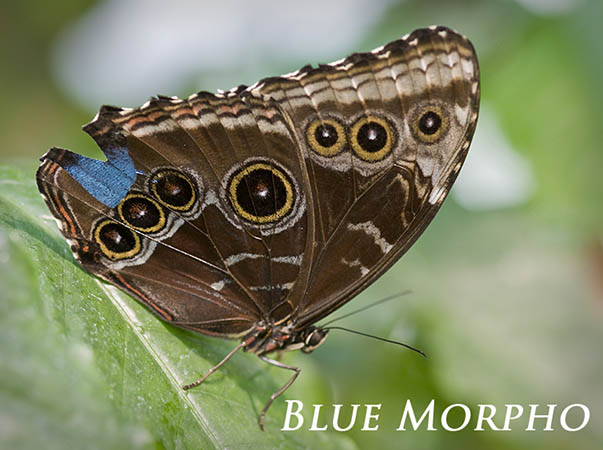Exotic Butterflies of the World
Blue Morpho
Morpho (sp.)
Brush-footed Butterfly(Nymphalidae) Family
Range This neotropical butterfly is found in places in Central and South America, including the Cerrado which is a vast tropical savanna in Brazil. Other locations include Mexico and Venezuela. Ancestors of the Morpho menelaus butterfly may have been distributed in the Andean region. Behavior Both sexes of the butterfly tend to inhabit the forest understory, but females are found near the tree tops when it is time to lay eggs. Both sexes have a slow and floppy flight pattern and feed on rotting fruit that has dropped to the ground. These butterflies tend to collectively emerge in the beginning and the end of the wet season in Cerrado. They tend to not appear in the middle of the wet season because the heavy rain can cause physical harm to their wings. This can be explained because of the Morpho menelaus may have been evolutionarily selected to synchronize with the availability of food determined by the climate. For protection from the rain, the Morpho menelaus prefers small and enclosed spaces. Egg These butterflies lay their eggs one by one on the underside of host plants. The eggs are very small, are pale green in color and shaped like dew drops. The eggs are laid so that the caterpillars may feed as soon as they hatch. Caterpillars These social caterpillars feed on Erythroxylum, Dalbergia, and Fabaceae, and may prefer to feed on new leaves of host plants since these new leaves are easier and more profitable to eat. The caterpillars are red brown in color with bright green spots. They are covered with bristles that release an irritant upon contact. Conversely, the peak of the caterpillar is in the dry season, a climate that is unsuitable for most animal communities. These caterpillars will enter diapause and delay pupation in order to survive this period and the lack of water. As the dry season continues, the caterpillar population declines due to predation. Adult One of the best predictors of adult butterfly occurrence is the number of zoochoric herbaceous species with ripe fruit. Adult emergence occurs primarily in the beginning of the wet season, when the climate and air humidity makes food resources plentiful and oviposition advantageous. The butterfly spends 3 to 4 weeks as an adult, and the entire life cycle is about 115 days. Adults fly along rivers, or anywhere that open land has been revealed. Adaptations Eyespots on wings are visual anti-predatory adaptations that have evolved in many species within Lepidoptera. The eyespots are usually dark circles surrounded by a brighter outer layer. The ‘pupil’ of the eye has a sparkle that mimics the natural reflection of the cornea. These eyes are thought to deflect a predator’s attack away from more vital organs and toward that spot on the wings. Bigger eyespots have also been shown to deter predators from attacking completely. M. menelaus specifically has an eyespot that is 6.8 mm in diameter on its ventral wings that it uses to help avoid predation. Coloration The wings of Morpho menelaus are a prime example of iridescent blue coloration in the insect world. The bright and iridescent colors of other butterflies are typically caused by optical interference, but the iridescent blue color of butterflies in the Morphidae family results due to the microstructures of the wings. Using SEM, scanning electronic microscope, and spectroscopy, the structure of Morpho menelaus' wings can be understood in greater detail..
Tucson, AZ.
Tucson Botanical Garden
See Wikipedia Morpho menelaus Pictures and Description


